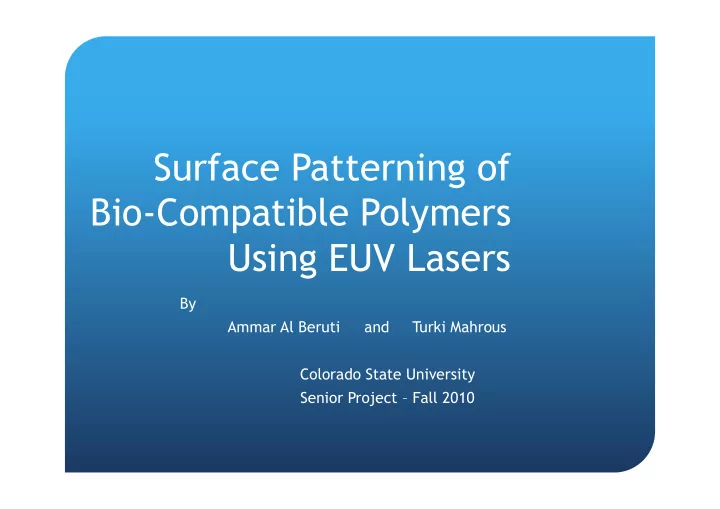

Surface Patterning of Bio�Compatible Polymers Using EUV Lasers Using EUV Lasers By Ammar Al Beruti and Turki Mahrous Colorado State University Senior Project – Fall 2010
Outline � Project Main Idea � Previous Work Preview � Why Biocompatible Polymers? � Project Description � Conclusions and Future Work � Budget � Questions?
Project Main Idea � Developing a methodology to produce nano�scale structures using biocompatible polymers � Using the effects of EUV lasers illumination (interference) (interference)
Previous Work Preview � Nanolithography Techniques: 1) Electron Beam Lithography 2) Focused Ion Beam Lithography 3) Colloidal Lithography 4) EUV Lithography Electron Beam * Picture taken from www.psiltd.co.uk
Previous Work Preview � What is Unique About EUV? � High�Energy Radiation � Short Wavelength (46.9 nm) δ = K . λ Sinθ
Previous Work Preview � Description of the EUV Laser
Previous Work Preview � Description of the EUV Laser
Why Biocompatible Polymers? � Applications: � Medical Implantation � High�Sensitivity Biosensors � Tissue Engineering Tissue engineered heart valve * Picture taken from http://en.wikipedia.org/wiki/Tissue_engineering
Why Biocompatible Polymers? � Research and Experimentation in Biopolymers � Tested 20 different biopolymers � Recommended Tecoflex SG�80A � Tried different concentrations � Concluded that biopolymers react to EUV radiation Tecoflex SG�80A
Project Description � Experiment EUV Polymer Mask Substrate Polymer Substrate Preparing Sample Exposure Analysis Photoresist Coating 1 2 3 4
Project Description 1 � Experiment 1) Preparing the Photoresist (0.83% Concentration) � Used Pro Explorer Balance to weigh the polymer (100 mg of Tecoflex SG�80A) (100 mg of Tecoflex SG�80A)
Project Description 1 � Experiment 1) Preparing the Photoresist (0.83% Concentration) � Used a 1000�micron pipette to measure the desired amount of solvent (12 mL of THF) desired amount of solvent (12 mL of THF)
Project Description 1 � Experiment 1) Preparing the Photoresist (0.83% Concentration) � Used the Sonic Bath method to dissolve the polymer in the solvent polymer in the solvent
Project Description 2 � Experiment 2) Preparing and Coating Samples � Cleave the Silicon wafer
Project Description 2 � Experiment 2) Preparing and Coating Samples � Clean the samples using Methanol and Acetone
Project Description 2 � Experiment 2) Preparing and Coating Samples � Use the Spin Coater to coat the samples
Project Description 2 � Experiment 2) Preparing and Coating Samples � Use the Hot Plate to bake the coated samples
Project Description 2 � Experiment 2) Preparing and Coating Samples � Attach the coated sample to the sample holder Nickel Mesh Mask Metal Grip
Project Description 3 � Experiment 3) Sample Exposure to EUV Laser � Place the sample holder in the chamber the chamber � Evacuate the chamber � Expose the sample
Project Description 4 � Experiment 4) Analyzing the Exposed Sample Microscope Atomic Force Microscopy (AFM)
Project Description � Results 1) First Sample � Scratches on the surface of the sample � Couldn’t see the pattern � Needed to repeat the experiment
Project Description � Results AFM Scan of Sample 1
Project Description � Results 2) Second Sample � Pattern was clear � Poor Quality (Contaminated) � Had to debug the error and repeat the experiment
Project Description � Results AFM Scan of Sample 2
Project Description � Results 3) Third Sample � Pattern is visible � Surface roughness � Granularity
Project Description � Results AFM Scan of Sample 3
Project Description � Results AFM Scan of Sample 3
Conclusions and Future Work � Conclusions � Proved that Tecoflex SG�80A can be patterned � Proved that the methodology is effective � Contamination � Photoresist is not stable
Conclusions and Future Work � Goals for Next Semester 1) Determining the penetration depth 2) Obtaining a very thin homogeneous layer of polymers • How We Will Address the Issues 1) Follow extra clean conditions 2) Explore different ways to mix the solution 3) Testing different spin coating protocols
Budget ���� �������� ����� Silicon Wafers 4 $20 O�ring (for laser) 1 $2 Plastic Syringes 5 $20 Glass Syringe 1 $8 Syringe Filters Syringe Filters 6 6 $18 $18 TEM Grids (Meshes) 1 $30 AFM (Per Hour) 1 hour $60 Masks 2 $10 Gloves 1 box $7 Methanol 1 $25 Acetone 1 $20 Compressed Nitrogen 1 $160 Total $380 * All expenses were covered by the ERC facility and the Chemistry Department at Colorado State University
Questions?
Thanks!
Recommend
More recommend